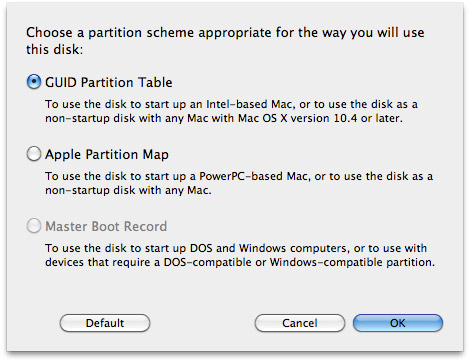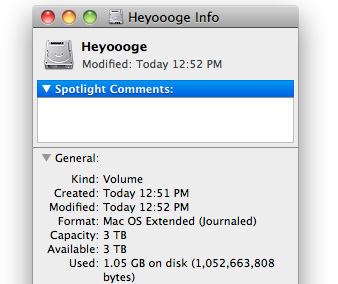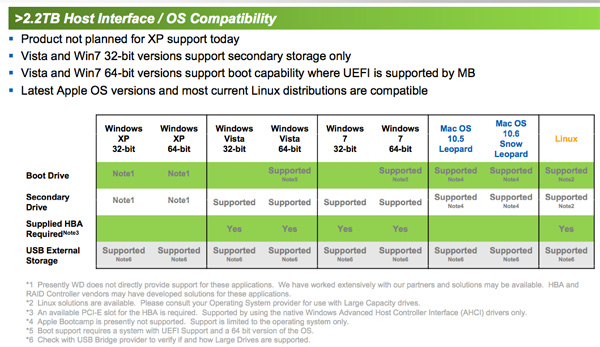Western Digital Caviar Green 3TB and My Book Essential 3TB Drives Reviewed
by Anand Lal Shimpi on October 19, 2010 1:43 PM EST- Posted in
- Storage
- HDDs
- Western Digital
- 3TB
The 2.19TB Barrier
I addressed this in my 3TB Seagate review back in August, so much of this is a rehash from the review back then with some new information toward the end of the page.
Pretty much all HDDs (and SSDs) are addressed using a scheme called Logical Block Addressing (LBA). The method is very, well, logical. Storage is addressed linearly, regardless of how the hardware itself is accessed. You start at LBA 0 and you go all the way up to the last address in your device.
The number of LBAs you can address is a function of your hardware and the style of partition you’ve applied to your drive.
Master Boot Record partitioning is by far the most common on PCs today. LBA 0 contains the Master Boot Record (MBR) and your BIOS looks at the contents of LBA 0 to determine how to boot.
Now LBAs under MBR partitions are addressed using 32-bit values, the maximum of which is 2^32 or 4294967296. Each LBA on a hard drive corresponds to a 512-byte sector value (even on 4K advance format drives, they still appear as 512-byte sector drives to the OS), so the largest partition you can have in a MBR partitioned drive is 4294967296 * 512-bytes or 2,199,023,255,552 bytes.
Hard drive manufacturers define 1TB as 1 trillion bytes. If we use that definition then the largest 32-bit MBR partition would be 2.199TB (2,199,023,255,552 bytes / 1,000,000,000,000). If we define 1TB as 1024^4 bytes (TiB) then the largest 32-bit MBR partition would be 2TiB (2,199,023,255,552 bytes / 1,099,511,627,776). Either way, with a 3TB drive there’s no way we’re getting a single 3TB partition using MBR.
In use on all Itanium and Intel based Macs (among other systems) is GPT (GUID Partition Table), and a feature of GPT is 64-bit LBA support.
With 64-bit LBAs the largest 512-byte sector drive we can address is 9.4ZB (Zettabytes - 10^21 or 2^70 bytes depending on if you’re counting in base 10 or 2). That’s an absurd amount of data.
GPT drives are supported as data drives in all x64 versions of Windows as well as Mac OS X and Linux. Below we have some screenshots of creating a GPT drive in Windows and OS X:

GPT Partition in Windows 7

GPT in Mac OS X
You’ll note that I said data and not boot drives. In order to boot to a GPT partition, you need hardware support. I just mentioned that your PC’s BIOS looks at LBA 0 for the MBR. Your BIOS does not support booting to GPT drives. GPT is however supported by systems that implement the successor to the BIOS: Intel’s Extensible Firmware Interface (EFI).
Intel based Macs don’t use a BIOS and instead have an EFI which allows them to boot to GPT drives. Most PC motherboards however do not have EFI support, and those that do may have bugs associated with the implementation.
I’m expecting to see the first round of motherboards with official 3TB HDD support in the coming weeks. Although consumers shouldn’t expect good support from motherboard makers until the first half of next year. Users of older boards may be out of luck as enabling EFI is still a low priority for most manufacturers.
BIOS support is only part of the problem. You SATA controller also needs to support 64-bit LBAs. Currently Intel’s storage drivers don’t support 64-bit LBAs. Running your ICH in Native IDE mode will work however.
AMD’s 8-series storage drivers do support 64-bit LBAs but I haven’t seen any AMD motherboards with EFI support.
In order to deal with all of the potential controller issues today, Western Digital bundles all 3TB drives with a HighPoint Rocket 620. The controller supports booting to a 3TB formatted drive if your motherboard has EFI support. But as I just mentioned, proper EFI support is tough to come by.

Western Digital expects that we’ll see both motherboard and storage controller support by Q2 2011, at which point it will stop shipping the HighPoint cards with 3TB drives.
The HighPoint adapter uses a Marvell 88SE9025 6Gbps SATA controller, although for some reason installing HighPoint’s drivers on the card (both at boot and under Windows) would cause the drive to disappear entirely. I had to rely on the drivers that ship with Windows 7.
Mac & Linux Support
Intel Macs already ship with EFI support so these drives should just work in a Mac. I popped one into a Nehalem Mac Pro and I confirmed it worked:

Linux is also covered if your distribution enables support for 64-bit LBAs. The full compatibility matrix is below:











48 Comments
View All Comments
pvdw - Wednesday, October 20, 2010 - link
I use Linux MD RAID 10 (near-copies) on my home "server". For those who don't know, this is a non-standard RAID level that simulates RAID-10 using only two drives. In addition to redundancy this provides read speed improvements and some write speed improvement. I've set up automatic backups to protect from user error; and use Linux, so no viruses (yet). So I'm protected from all but fire/theft/bomb/hurricane/etc. For this I have off-site storage that syncs on a less frequent basis.Since we've had a number of power cuts here recently, the RAID setup also gives extra security.
Also, I don't know where you get your data from. None of my customers have lost data due to malware (I recover data from systems riddled with them), theft, or fire, but they have due to disk failure. I would put user error at the top of the list. I can see theft moving up the list due to the increase in portable data storage (tablets, smartphones, etc.)
daneren2005 - Wednesday, November 23, 2011 - link
You must be kidding me. Although it happens, not a single person I know has ever had a fire in their house. House break ins once again happen, but are not every day occurrences. I haven't heard of a widespread wipe virus since the early XP days. And when it comes right down to it, the common backup method (external HDD) prevents NONE of these things either. For 99.9% of the population, a RAID 1 provides IDENTICAL protection as an external backup drive. Especially since most consumer backups delete files that were deleted on the main drive, anything but a immediately noticed user error/virus wipe (and usually getting it out of the trash is going to be enough for these cases) would be propagated to the external drive as well.Now I both backup (update ~once a moth and store at brothers house) and RAID my data, but I do both because neither is enough by itself, but RAID isn't any less of a backup option then external backups.
CharonPDX - Tuesday, October 19, 2010 - link
I've had Intel Desktop boards for a few years that support EFI boot. I installed Windows 7 this way onto a 3 TB Intel chipset RAID a while ago, no problem. (Boot to the EFI installer on the Windows 7 disc, rather than the BIOS installer.)TSnor - Tuesday, October 19, 2010 - link
re: "Simply look at worst case seek time and you’ll get an idea for how quickly the platters are spinning" Worse case seek time should be the time it takes the heads to move from one extreme to another. While there might be a correlation between seek time and RPM, it would be because high performance drives tend to maximize both and green drives accept compromises on both.re: "Random performance is significantly lower, presumably because of the translation that happens at the USB controller level. " No, reading random 4K records is much harder for disk drives than reading sequential data. The R/W heads need to get positioned to the correct track between each random IO operation (that's the 'seek time' above) and the correct data has to rotate under the R/W heads (that's rotational latency effected by drive RPM). Reading sequential data the disk drive just reads each record as it comes under the R/W head, with a 1 cylinder (very short) seek to get to the next cylinder. This is why rotating disks can compete with SSDs for sequential data but get crushed on random data.
dertechie - Tuesday, October 19, 2010 - link
He's comparing the 4K reads of the external drive to the 4K reads of internal and other HDDs, not to sequential reads. If you actually look, you'll note that the drive lost over half of its random 4K read performance when using it over USB3 (0.18 MB/s) compared to the numbers it posts as an internal drive (0.40 MB/s). Write performance also dropped compared to internal, but not as much.TSnor - Tuesday, October 19, 2010 - link
re: "If you actually look..." ok. I agree with you.Sufo - Wednesday, October 20, 2010 - link
um, pretty sure he was comparing the internal drive to the external one here (so essentially sata to usb 3). I would be surprised if Anand had forgotten that random reads/writes are slow work on mechanical drives - it's not been that long since he published the last round of articles on the subject...Sufo - Wednesday, October 20, 2010 - link
oops sorry, didn't check next page >_<Dainas - Tuesday, October 19, 2010 - link
Anand,Can you please do some reviews on Samsung's Spinpoints? Only asking because Western Digital and Seagate always seem to have this or that issue with their +1TB drive. Also from what I've seen Samsungs efforts are also consistently faster and more reliable. Would be nice to know what you think of them.
musicman1352000 - Tuesday, October 19, 2010 - link
Yes please!Also, what happened to the noise figures?